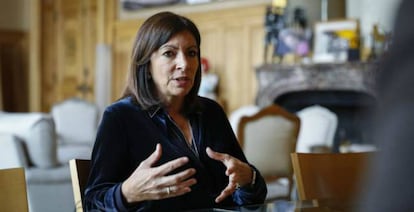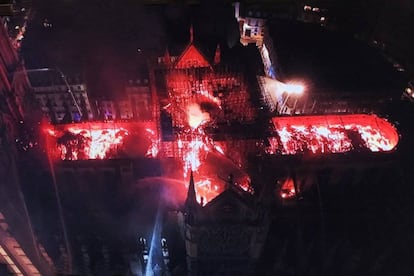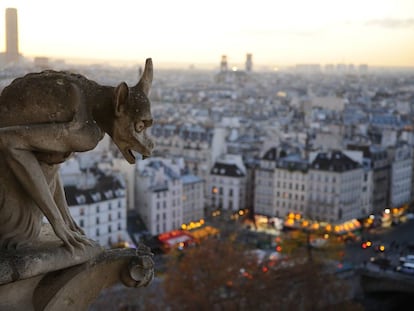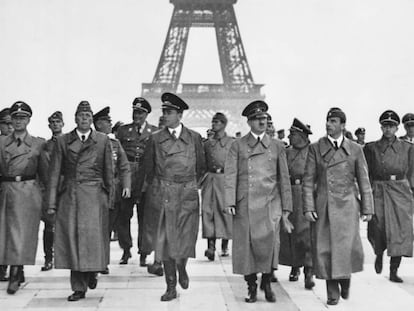Mayor of Paris: “The power of Notre-Dame goes beyond the religious”
As donations pour in from all over the world, Anne Hidalgo reflects on the cathedral and its global significance

Anne Hidalgo has been the mayor of Paris for five years. During this time she has been through several harrowing experiences, such as the terrorist attacks of 2015. But there are still things that surprise her. “Whatever happens here creates a universal, planetary emotion. I am the mayor of this city, and each time it moves and fascinates me,” she said in an interview with correspondents from the Leading European Newspaper Alliance (LENA).
It was extremely dangerous. But they went in. And they won
Paris Mayor Anne Hidalgo
“Victor Hugo said that Paris belonged to mankind,” she muses, alluding to the 19th-century author of the famous novel Notre-Dame de Paris, known in English as The Hunchback of Notre-Dame.
Hidalgo, who was born in the southern Spanish province of Cádiz in 1959 and moved with her family to Lyon at the age of two, looks out of the window of her office in the Hôtel de Ville. “I was here when we saw the first plumes of smoke,” she remembers. The cathedral, or what remains of it after it was consumed by a fire on Monday, can be seen from the window. Its two towers remain standing, but the roof was ravaged and the spire did not survive the flames. Holding back tears, Hidalgo remembers the helplessness she felt that night: “Although on the other hand the firefighters were there, and when Paris’ firefighters arrive at the scene, you know that everything is going to be under control.”

One image from that long and uncertain night, when it was feared the entire cathedral could collapse, has stayed with her. Hidalgo was in a room at the police prefecture next to Notre-Dame, alongside French President Emmanuel Macron, Prime Minister Édouard Philippe, Paris Archbishop Michel Aupetit, the rector of the cathedral, Patrick Chauvet, and the general of the firefighters, Jean-Claude Gallet.
“The general said that action was needed to save the towers and that 10 men would have to go up, aware of the risk they would be taking. In other words, 10 men who might or might not come down again. It was a moment … Nobody speaks, we all trust him,” she recounts, switching to the present tense. “We will all remember that moment: his face and our own faces, together in a moment of reverence.”
€800 million has been raised since the fire to rebuild Notre-Dame
Afterwards they went to the square in front of the cathedral.They received aerial images from the drones, which provided valuable help to the operation. On the screen, the firefighters were little dots of light moving inside the tower as they tried to save it from the flames. “It was extremely dangerous. But they went in. And they won,” she says.
There were no deaths and only two police officers and a firefighter were slightly injured. Meanwhile Notre-Dame, although damaged, remains standing. Now this nearly 1,000-year-old landmark has become the subject of two debates. The first is whether the fire could have been prevented. Hidalgo says, “it’s too early to say. We know these buildings are vulnerable in general when there is restoration work going on.”
The second debate is how to rebuild it. Macron wants the job done in five years. But is that enough time? “I think so, without a doubt,” says Hidalgo. “Often in these types of situations, the most difficult part is raising funds and having the resources for the reconstruction.” According to the mayor, a few years ago an agreement was signed between the city of Paris, Notre-Dame and the French state, which owns the cathedral, to raise money for renovation work. The project began with €6 million, which was provided in equal parts by the authorities – far less than the €800 million that has been raised so far after the fire. “The national and international solidarity is so great that I think there will be no problem getting the restoration underway,” she says.
Notre-Dame is perhaps the mother of all churches, a world reference, like Bethlehem Paris Mayor Anne Hidalgo
Hidalgo, considered one of the most relevant Socialist politicians in France today, is aware of the criticism against the billionaires who have donated tens of millions of euros to rebuild Notre-Dame. But she does not share them. “They know I am in favor of redistribution policies and that I am a social-democrat who believes we live in a country and in a Europe where there is not enough social justice,” she says. “But I also think it is important that the people with the most means, the large fortunes of France and the world, are deciding to contribute.”
“You know what?” she asks. “I think it is history and heritage that unite us. In the defense of heritage there are humanist values at play, and if they are expressed this way, all the better.”
Paris tugs at the heartstrings of the world. And so does Notre-Dame, a Catholic temple which has remained an undisputed symbol of the French capital, in a country where Catholicism is in crisis and there is a strict separation of the church and state. “The role of religious and political powers in France are very clear. And today the power of Notre-Dame goes beyond the religious,” says Hidalgo. “It is perhaps the mother of all churches, a world reference, like Bethlehem, the Church of the Holy Sepulchre and Rome. But more than that, it is a monument and a place that belongs to everyone who loves Paris and loves this story.”
Hidalgo is not surprised that sales of The Hunchback of Notre-Dame, the book that helped build the myth of the cathedral, have skyrocketed. “It is [Victor Hugo] who turned this story into our story.”
English version by Melissa Kitson.
Tu suscripción se está usando en otro dispositivo
¿Quieres añadir otro usuario a tu suscripción?
Si continúas leyendo en este dispositivo, no se podrá leer en el otro.
FlechaTu suscripción se está usando en otro dispositivo y solo puedes acceder a EL PAÍS desde un dispositivo a la vez.
Si quieres compartir tu cuenta, cambia tu suscripción a la modalidad Premium, así podrás añadir otro usuario. Cada uno accederá con su propia cuenta de email, lo que os permitirá personalizar vuestra experiencia en EL PAÍS.
¿Tienes una suscripción de empresa? Accede aquí para contratar más cuentas.
En el caso de no saber quién está usando tu cuenta, te recomendamos cambiar tu contraseña aquí.
Si decides continuar compartiendo tu cuenta, este mensaje se mostrará en tu dispositivo y en el de la otra persona que está usando tu cuenta de forma indefinida, afectando a tu experiencia de lectura. Puedes consultar aquí los términos y condiciones de la suscripción digital.
More information
Archived In
Últimas noticias
Half of Scotland is in the hands of 420 property owners
Pinochet’s victims grapple with José Antonio Kast’s rise in Chile
Reinhard Genzel, Nobel laureate in physics: ‘One-minute videos will never give you the truth’
From digital curfews to blocking apps: How technology experts protect their children online
Most viewed
- Pablo Escobar’s hippos: A serious environmental problem, 40 years on
- Reinhard Genzel, Nobel laureate in physics: ‘One-minute videos will never give you the truth’
- Why we lost the habit of sleeping in two segments and how that changed our sense of time
- Charles Dubouloz, mountaineering star, retires at 36 with a farewell tour inspired by Walter Bonatti
- The Florida Keys tourist paradise is besieged by immigration agents: ‘We’ve never seen anything like this’











































